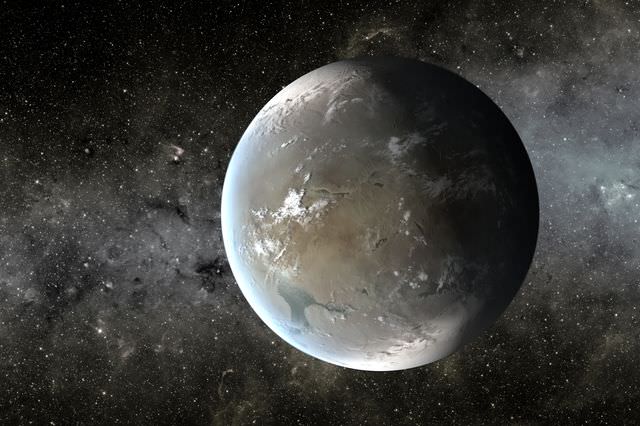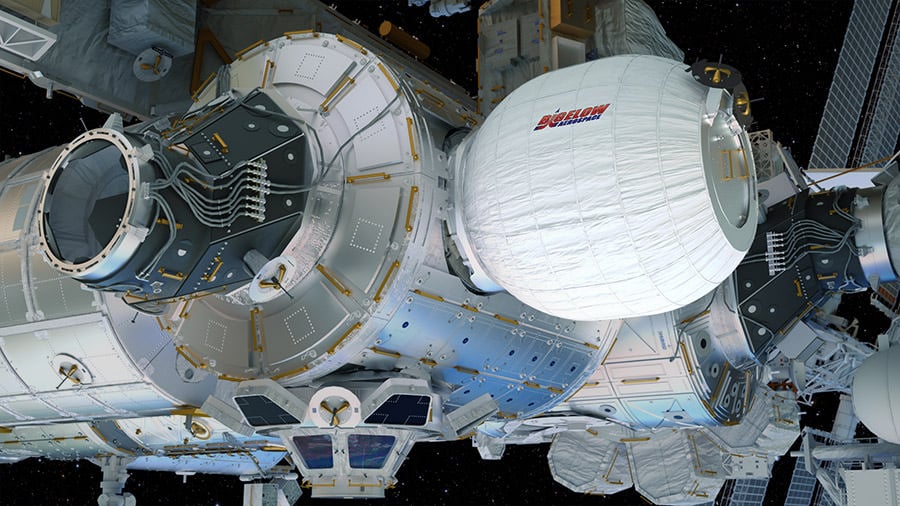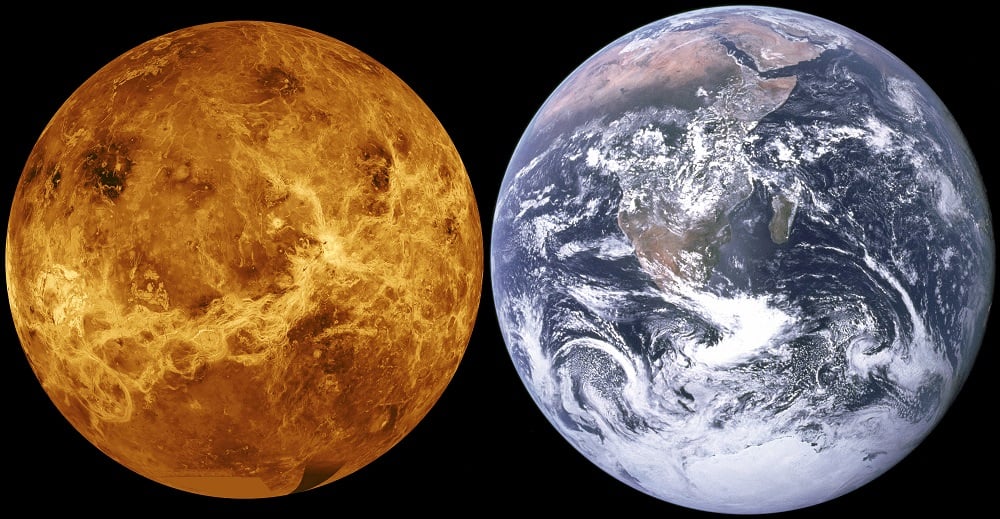
The latest release by the New Horizons mission - a photo mosaic of pictures taken during its flyby - provides the clearest image of Pluto yet!
Continue reading

WALLOPS ISLAND, VA – The soon to be reborn Orbital ATK Antares commercial rocket sporting new first stage engines has been raised at its repaired launch pad on Virginia's eastern shore for a long awaited test firing of the powerplants. The static test firing is now slated to take place in less than 3 days on Tuesday evening, May 31.
Continue reading

Mars and Earth have many similarities, but the length of a year is not one of them! Compared to Earth, a Martian year is almost twice as long
Continue reading

CAPE CANAVERAL AIR FORCE STATION, FL. - Atop a billowing plume of fire and smoke a SpaceX Falcon 9 rocket soared to space this afternoon, Friday, May 27, as the crackling thunder of the engines roared across the Florida space coast and the company scored a stunning double headed launch and landing success.
Continue reading

A new study shows that there are multiple scenarios where exoplanet Kepler 62f could support life.
Continue reading

Continue reading

Blue Origin will perform its next test flight of the New Shepard rocket with a faulty parachute system on the crew capsule.
Continue reading

CAPE CANAVERAL AIR FORCE STATION, Fla. - Thursday's (May 26) planned blastoff of an upgraded SpaceX Falcon 9 rocket on a lucrative commercial mission to deliver a Thai telecommunications satellite to orbit, was postponed in the final stages of the countdown after engineers discovered a technical glitch in the booster's second stage.
Continue reading

Neptune, being the farthest planet from the Sun (sorry Pluto!) is now recognized as also being the coldest body in the Solar System
Continue reading

We've lived on planet Earth all of our lives, but how much does the average person know about the planet that's beneath our feet?
Continue reading

Stars are hot, we know that, everyone knows that. But are there "cold stars"? It all depends on what you mean by the word "cold" and the word "star".
Continue reading

A team of Armenian researchers has proposed a new answer to why time only moves in one-direction: it's all because of dark energy!
Continue reading

Volcanic eruptions are driven by a combination of mechanisms, which include pressure and heat in the Earth's mantle, as well as tectonic activity
Continue reading

NASA's proposed new budget is mostly good news, though some planned missions will not be funded.
Continue reading

Get ready. Saturn reaches opposition for 2016 at the start of June, making it the best time to track down the ringed planet.
Continue reading

CAPE CANAVERAL AIR FORCE STATION, Fla. - Just three weeks after SpaceX's last launch from their Florida launch base, the growing and influential aerospace firm is deep into commencing their next space spectacular - targeting this Thursday, May 26, for launch of a Thai comsat followed moments later by a sea landing attempt of the booster on a tough trajectory.
Continue reading

The BEAM (Bigelow Expandable Activity Module) is attached to the International Space Station, and will be carefully inflated on Thursday, May 26th.
Continue reading

Using data provided by the New Horizon's spacecraft, scientists and the New York Times have created app that lets people to take a 3D VR tour of Pluto
Continue reading

Thanks to breakthroughs like Breakthrough Starshot, it may be easier to find extra-terrestrial intelligence, by looking for signs of laser beams!
Continue reading

A mysterious plume seen on Mars four years ago may have been caused by the impact of a large solar storm.
Continue reading

Paul Patton begins a three-part series on the evolutionary biology of aliens. Will they follow the same direction as life on Earth?
Continue reading
Continue reading

If you accelerate at 1G, you can create artificial gravity inside your spaceship. And there's the added advantage that you can cross billions of light years within a human lifetime. How far can we travel?
Continue reading

Most people think Mt. Everest is the highest point on Earth, but this is not so. Owing to Earth's peculiar shape, it's actually Mt. Chimborazo
Continue reading

America's first ever mission designed to retrieve samples from the surface of an asteroid and return them to Earth - OSIRIS-Rex - has arrived at its Florida launch base for processing to get ready for blastoff barely three and one half months from today.
Continue reading

Given its distance from the Sun, and the nature of its composition, Neptune is renowned for being the coldest planet in our Solar System
Continue reading

The difference between lava and magma, which is rather important when it comes to volcanic activity and geology, is just a question of location
Continue reading

Continue reading

The focus of space exploration, and exploitation, has long been the technologies required. But there's a legal aspect to space exploration, too.
Continue reading

A a distant gas giant, Jupiter takes a considerable amount of time to orbit our Sun. In act, a single year on Jupiter is equal to almost 12 years on Earth
Continue reading

The Hubble Space Telescope gets in the act with a spectacular new close-up of Mars taken just days before opposition. We also look at what you'll be able to see both with the naked eye and through the telescope.
Continue reading

Orbital ATK has unveiled a practical new proposal to build a near term man-tended outpost in lunar orbit that could launch by 2020 and be operational in time for a lunar link-up with NASA's Orion crew module during its maiden mission, when American astronauts finally return to the Moon's vicinity in 2021 - thus advancing America's next giant leap in human exploration of deep space.
Continue reading

When our Venus (aka. "Earth's Twin") orbits between the Earth and the Sun (i.e. during an interior conjunction), it becomes Earth's closest neighbor
Continue reading

With Pluto in its rear-view mirror, New Horizons is heading towards its next target, and sending back valuable science on its way.
Continue reading

Since ancient times, scientists have debated the true nature of light. Despite the progress we've made, there are still mysteries left to be resolved
Continue reading

The next Orion crew module in line to launch to space on NASA's Exploration Mission 1 (EM-1) has passed a critical series of proof pressure tests which confirm the effectiveness of the welds holding the spacecraft structure together.
Continue reading

Scientists in Australia have found evidence of an enormous asteroid impact about 3.5 billion years ago. But the site of that impact remains a mystery.
Continue reading

According to a recent study from the Carl Sagan Institute, aging red giant stars could still have habitable zones that create life on its distant planets
Continue reading

Rolling rolling rolling! Yee-haw!
2 By Sea, 1 By Land. The 3rd recovered Falcon 9 booster has joined her siblings inside SpaceX's gleaming new processing hangar, laying side-by-side at Launch Complex 39A at NASA's Kennedy Space Center (KSC) in Florida.
Continue reading

Pluto and Haumea have long been thought of as cousins. But a new study highlights Haumea's lack of small, icy moons, and has astronomers puzzled.
Continue reading

Continue reading

Simply put, air resistance (aka. drag) describes the forces that act opposite to an object's velocity as it travels through an atmosphere
Continue reading

Continue reading

In the constellation of Ophiuchus lies the M14 globular cluster, a loose concentration of stars spanning 100 light years, 300,000 light-years from Earth
Continue reading

Thanks to astronaut Tim Peake, people here on Earth have been treated for the first time to an image of what a chipped window aboard the ISS looks like!
Continue reading

Why this weekend's Full Moon is considered 'blue'... but not in the usual sense.
Continue reading

An upgraded version of Orbital ATK's commercially developed Antares rocket has at last rolled out to its launch pad on the Virginia shore - thus paving the path for a high stakes first stage engine test looming "in the next few weeks," according to the aerospace firm.
Continue reading

Using the largest 3-D map of the Universe to date, an team of researchers has shown that Einstein's theory of general relativity holds up 100 years later
Continue reading

The Hubble Space Telescope takes a deep look into the Comet 252P/LINEAR and discovers a spinning jet. We look at the jet then learn how you can still track this comet with your own telescope.
Continue reading

As completion nears for the prototype of Boeing's first Starliner astronaut taxi, the firm announced a slip into 2018 for the blastoff date of the first crewed flight in order to deal with spacecraft mass, aerodynamic launch and flight software issues, a Boeing spokesperson told Universe Today.
Continue reading

 Universe Today
Universe Today















































